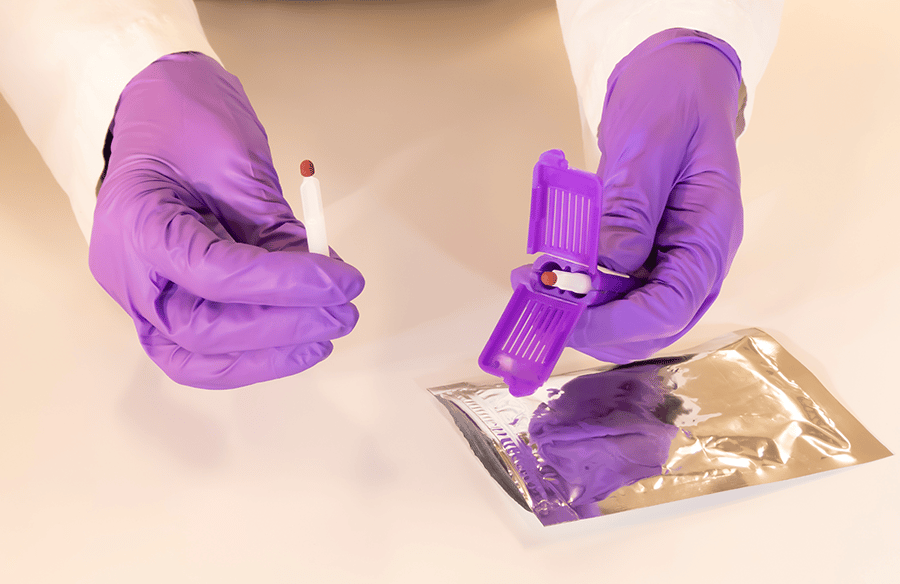Share this
VAMS method measures MEK1/2 inhibitor for PK studies
by James Rudge, PhD, Technical Director, Trajan on Jan 31, 2022 9:00:00 AM
An article published by Eric Thomas et al at Covance (now Labcorp Drug Development) and Astra Zeneca in the July 2020 issue of Bioanalysis, reported on a method to measure the MEK1/2 inhibitor selumetinib (AZD6244) from VAMS® extracts in blood collected with Mitra® devices.
 The paper is entitled “Novel LC–MS/MS method for the determination of selumetinib (AZD6244) in whole blood collected with volumetric absorptive microsampling.” It describes the development and validation of the new MEK1/2 inhibitor extracted from dried blood VAMS microsamples. One potential application for this assay would be for a non-adult cohort where reduced sample volume collection would be desirable.
The paper is entitled “Novel LC–MS/MS method for the determination of selumetinib (AZD6244) in whole blood collected with volumetric absorptive microsampling.” It describes the development and validation of the new MEK1/2 inhibitor extracted from dried blood VAMS microsamples. One potential application for this assay would be for a non-adult cohort where reduced sample volume collection would be desirable.
What is Selumetinib And What Does it Treat?
Selumetinib is a class of drugs that act as an MEK1/2 inhibitor. MEK stands for mitogen-activated protein kinase kinase. A mitogen is a small molecule that induces cells to begin or enhance cell division.
The drug selumetinib acts to inhibit this activity. Indeed, selumetinib has recently been approved for the treatment of plexiform neurofibromas related to Neurofibromatosis type 1 (NF1) in pediatric patients. Neurofibromatosis type 1 is a rare genetic disorder of the nervous system that is usually diagnosed in early childhood.
It is associated with the growth of plexiform neurofibromas (tumors) along the nerves in the body, affecting skin, bone, eyes the spine and other areas. If left untreated, plexiform neurofibromas continue to grow, causing symptoms and impacting the tissue that covers and protects nerves. Most neurofibromas are noncancerous, but some may eventually become malignant.
Why Volumetric Absorptive Microsampling?
Pharmacokinetic (PK) studies in preclinical research had been previously developed to measure selumetinib (including its metabolites) in traditional human matrices such as plasma, plasma ultra-filtrate, human dialysate, and urine.
Eric Thomas et al needed to develop a method for non-adults, namely pediatric patients, where reduced blood volume collection would be desirable.
For this purpose, they looked to whole blood sampling approaches rather than traditional plasma approaches. Several blood sampling techniques were considered, including finger-stick methods with dried blood spot (DBS) cards and Mitra devices with VAMS.
However, there were a few known concerns pertaining to DBS, including contamination risks with sub-punching as well as issues with spot homogeneity and spot size pertaining to hematocrit (%HCT). Indeed, the authors highlighted that contamination during sub-punching DBS cards had previously been reported as a concern.
Furthermore, they quoted recommendations from the EBF DBS-microsampling consortium on the requirement of blank cards to be used to punch between samples and further, to run samples in order of increasing concentration to mitigate such contamination concerns.
Nevertheless, they determined that dried blood microsampling would be desirable as this would enable remote collection by the patient or a caregiver at home without the need to visit a clinic or lab for a blood draw.
They chose Mitra due to its volumetric collection properties and stated that “This approach mitigates challenges with biases and variability, largely driven by hematocrit and nonhomogeneity, associated with sub-punches analyzed for DBS.”

They also stated that VAMS was “rapidly expanding as a replacement to traditional DBS techniques.”
Object of the MEK1/2 Inhibitor PK Study
There had been no previous method developed on selumetinib, so the team decided to develop and validate a robust assay using VAMS. They believed the VAMS assay would have the potential to be used in support of clinical trials.
Methods, Results and Discussion
- A robust and rapid LC-MS/MS assay for selumetinib was developed and validated to meet Food and Drug Administration (FDA) bioanalytical guidelines.
- For extraction using Mitra devices with VAMS, and to minimize any possible contamination, the research team used the back of a pipette tip to remove the VAMS tips from the Mitra sampler bodies for placing into 96 well plates. To further mitigate any possible cross contamination when placing Mitra samplers in 96 well plates, they sealed the plates before extraction.
- Extraction of the tips included employing methanolic ammonia involving both vortexing and sonication, centrifugation dry-down and reconstitution. Extraction recovery was reported to be 100%.
- In terms of stability, samples were stored under desiccation and stored for 126 and 378 days; selumetinib was stable at room temperature for up to 126 days and at -10-30° C for up to 378 days.
- The researchers reported a clear advantage in collecting small-volume samples of 10 µL using Mitra devices compared to collecting larger volumes of whole blood (50 µL), however, they highlighted that extraction method optimization was required to hit the LLOQ to the limited sample volume.
- The group highlighted a potential disadvantage of volumetric collection: to conduct any sample reanalysis, more than one sample would need to be collected. They did, however, later say that “this assay presented no appreciable difficulty for the lab in execution of sample analysis; removal of the device tip prior to extraction presents a routine, robust workflow.”
Study Authors' Conclusions and Future Perspectives
- Developed a selective and sensitive fast procedure for determination of dried human blood using Mitra devices with VAMS
- Assay allowed for comparison between venous and peripheral blood absorbed onto VAMS tips of Mitra devices
- The assay has been used in a phase 1 clinical trial; bridging PK data between “different blood-derived matrices,” which shows potential for future clinical trials involving selumetinib PK studies
- The authors believe that “this assay presents a paradigm for future drug development in which standard matrices may be used in early clinical trials, with deployment of microsampling devices to follow, to allow for remote collection of samples.”
- They also believe the assay has the potential to be “the gold standard for selumetinib analysis” providing excellent flexibility in sample collection without affecting the performance of the assay
- Reducing the invasiveness of sampling appeals to patients; traditional sampling methods are more challenging with pediatric patients
- They commented that next-generation microsampling devices reduce the need for in-clinic visits, reducing the burden on patients
- They demonstrated “in this work that the Mitra device provides a robust platform for analysis of selumetinib”
- The researchers envision a future where microsamples could well be preferable for bioanalysis moving forwards
Final Thoughts
Clinical trials are critical to allowing new medicines to be developed and commercially deployed for use. However, trials are costly, and can be burdensome and inconvenient (especially in pediatrics) for those who enroll in them.
This sometimes leads to some patients voluntarily dropping out of the trials before they reach completion. Remote microsampling provides an alternative way to run drug trials that minimize the impact on the patient yet allow for critical data to be gathered.
The work reported by Eric Thomas et al demonstrated that high-quality data can be gained from 10 µL microsamples to allow them to support future studies on selumetinib.
This study paper was summarized for our readers by James Rudge, PhD, Neoteryx Technical Director. This is curated content. To learn more about the important research outlined in this review, visit the original article published in the Journal of Pharmaceutical and Biomedical Analysis.

Visit our Technical Resource Library to read more study papers and presentations that used Mitra devices with VAMS.
Share this
- Microsampling (206)
- Research, Remote Research (119)
- Venipuncture Alternative (105)
- Clinical Trials, Clinical Research (83)
- Mitra® Device (73)
- Therapeutic Drug Monitoring, TDM (51)
- Dried Blood Spot, DBS (39)
- Biomonitoring, Health, Wellness (30)
- Infectious Disease, Vaccines, COVID-19 (24)
- Blood Microsampling, Serology (23)
- Omics, Multi-Omics (21)
- Decentralized Clinical Trial (DCT) (20)
- Specimen Collection (18)
- Toxicology, Doping, Drug/Alcohol Monitoring, PEth (17)
- Skin Microsampling, Microbiopsy (14)
- hemaPEN® Device (13)
- Preclinical Research, Animal Studies (12)
- Pharmaceuticals, Drug Development (9)
- Harpera Device (7)
- Industry News, Microsampling News (5)
- Antibodies, MAbs (3)
- Company Press Release, Product Press Release (3)
- Environmental Toxins, Exposures (1)
- July 2025 (1)
- May 2025 (1)
- April 2025 (2)
- December 2024 (2)
- November 2024 (1)
- October 2024 (3)
- September 2024 (1)
- June 2024 (1)
- May 2024 (1)
- April 2024 (4)
- March 2024 (1)
- February 2024 (2)
- January 2024 (4)
- December 2023 (3)
- November 2023 (3)
- October 2023 (3)
- September 2023 (3)
- July 2023 (3)
- June 2023 (2)
- April 2023 (2)
- March 2023 (2)
- February 2023 (2)
- January 2023 (3)
- December 2022 (2)
- November 2022 (3)
- October 2022 (4)
- September 2022 (3)
- August 2022 (5)
- July 2022 (2)
- June 2022 (2)
- May 2022 (4)
- April 2022 (3)
- March 2022 (3)
- February 2022 (4)
- January 2022 (5)
- December 2021 (3)
- November 2021 (5)
- October 2021 (3)
- September 2021 (3)
- August 2021 (4)
- July 2021 (4)
- June 2021 (4)
- May 2021 (4)
- April 2021 (3)
- March 2021 (5)
- February 2021 (4)
- January 2021 (4)
- December 2020 (3)
- November 2020 (5)
- October 2020 (4)
- September 2020 (3)
- August 2020 (3)
- July 2020 (6)
- June 2020 (4)
- May 2020 (4)
- April 2020 (3)
- March 2020 (6)
- February 2020 (3)
- January 2020 (4)
- December 2019 (5)
- November 2019 (4)
- October 2019 (2)
- September 2019 (4)
- August 2019 (4)
- July 2019 (3)
- June 2019 (7)
- May 2019 (6)
- April 2019 (5)
- March 2019 (6)
- February 2019 (5)
- January 2019 (8)
- December 2018 (3)
- November 2018 (4)
- October 2018 (7)
- September 2018 (6)
- August 2018 (5)
- July 2018 (8)
- June 2018 (6)
- May 2018 (5)
- April 2018 (6)
- March 2018 (4)
- February 2018 (6)
- January 2018 (4)
- December 2017 (2)
- November 2017 (3)
- October 2017 (2)
- September 2017 (4)
- August 2017 (2)
- July 2017 (4)
- June 2017 (5)
- May 2017 (6)
- April 2017 (6)
- March 2017 (5)
- February 2017 (4)
- January 2017 (1)
- July 2016 (3)
- May 2016 (1)
- April 2016 (2)


No Comments Yet
Let us know what you think